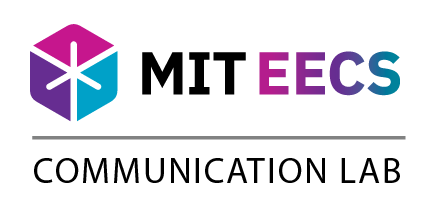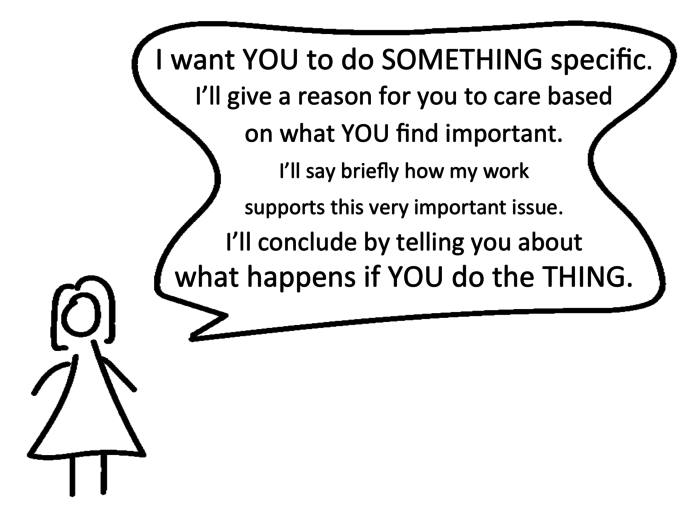Developed in collaboration with Dr. Dan Pomeroy, manager of MIT’s International Policy Lab.
Criteria for Success
A successful elevator pitch…
- Puts your bottom line up front; start with what you want them to do.
- Uses a short analogy instead of facts and statistics.
- Connects with the interests or values of the policy maker.
- Is executed in ~30 seconds.
Structure Diagram
Purpose
A policy-focused “elevator pitch” conveys, as concisely as possible, the following:
- A recommendation that you want a policy maker to act on,
- Why they should want to act, and
- What the results of that action will be
Unlike policy memos, full meetings, or presentations, it does not need to include a detailed plan of action. Instead, it should identify a slightly broader set of topics and pull the audience in so they’ll want to discuss the details.
These elevator pitches can be used at the start of meetings with policy makers to help set the tone and agenda for the meeting. They are also very valuable when attempting to initiate a longer conversation with someone who might normally only have a short time to talk with you.
Analyze Your Audience
A successful pitch prompts the listener to respond, “Interesting–tell me more!” All decisions about content and delivery should be based on what will engage your specific audience.
Skills
Select pitch content by answering key questions
- Why am I meeting with or talking to this person?
- What aspect of my work will be most exciting to my audience?
- How can I best frame my work to connect with their values or interests?
Your pitch should be tailor-made for your audience: select the information that will be most compelling to that specific person.
Use simple language and natural delivery
The way we write is different from the way we speak. When drafting your pitch on paper, you might find that your sentences and words tend to be longer and more complicated. This structure is nearly always overly rigid for a pitch and will feel forced when you try to deliver it aloud. Additionally, your audience will likely have trouble following your ideas. Keep the sentence structure and words simple so that your delivery feels natural and your audience can follow the ideas you are presenting.
Keep it concise
Start by drafting a pitch for the action you want. Don’t overthink it. Just jot down how you might respond to someone asking, “So what can I do for you?”
You may come up with something pressing and important, but long and detailed. Listeners have a short attention span. To maximize your audience engagement, your pitch should not be longer than about 30 seconds.
To parse down your draft, cross out all the nonessential words until you feel you cannot cross out any more. Don’t worry about leaving complete sentences or phrases—push yourself to cut as much as possible. Now that you have a small handful of keywords, insert as few words as possible to link together these concepts. Don’t worry about keeping the keywords in their original order: rearrange your draft until it creates a cohesive narrative.
Example Pitch Writing
Step 1: Start with a short description of your research.
My research is on licensing of next generation nuclear power plants. There is very limited experience in the United States with the design, construction, operation, and licensing of next generation non light water or advanced nuclear reactors. These reactors are very different than the existing fleet of nuclear reactors; the Nuclear Regulatory Commission has little to no experience reviewing the safety these designs and lack the tools and analysis techniques necessary to independently assess their safety. Additionally, the current regulations have been optimized for the existing fleet so new regulations or exemptions to existing regulations will be required before a designer can even submit a license of an advanced nuclear reactor design. My research group focuses on methods to develop new regulations and analysis tools to provide a licensing pathway for advanced nuclear reactor designs and ensure that we’re safely designing, constructing, and operating the next generation of nuclear power plants.
Step 2: Bold the most important words or concepts.
My research is on licensing of next generation nuclear power plants. There is very limited experience in the United States with the design, construction, operation, and licensing of next generation non light water or advanced nuclear reactors. These reactors are very different than the existing fleet of nuclear reactors; the Nuclear Regulatory Commission has little to no experience reviewing the safety these designs and lack the tools and analysis techniques necessary to independently assess their safety. Additionally, the current regulations have been optimized for the existing fleet so new regulations or exemptions to existing regulations will be required before a designer can even submit a license of an advanced nuclear reactor design. My research group focuses on methods to develop new regulations and analysis tools to provide a licensing pathway for advanced nuclear reactor designs and ensure that we’re safely designing, constructing, and operating the next generation of nuclear power plants.
Step 3: Combine the rearranged words to create a concise narrative, while adding as few extra words as possible.
The [Nuclear Regulatory Commission lacks] [the tools and analysis techniques necessary to independently assess] the [next generation of nuclear power plants] due to their [limited experience] with [advanced nuclear reactors]. My research is on [new regulations and analysis tools] that can help [ensure] the [safety] of these designs.
Step 4: Add context for the audience. What do you want them to do and why should they want to do it? For the end of the pitch, what will the impact of their decisions be?
What? Start developing regulations for advanced nuclear power plants.
Why? Advanced nuclear power plants can provide carbon free power and help fight climate change.
Impact? Having a system to support advanced nuclear means faster deployment of low carbon energy sources.
Step 5: Write out the full pitch and revise.
The Nuclear Regulatory Commission needs to begin developing regulations for advanced nuclear power plants. [What]
These advanced nuclear reactors could provide the carbon free energy we need to address climate change issues. [Why]
The Nuclear Regulatory Commission lacks the tools and analysis techniques necessary to independently assess the next generation of nuclear power plants due their limited experience with advanced nuclear reactors. My research is on new regulations and analysis tools that can help ensure the safety of these designs. [Research]
Creating regulations for advanced nuclear power plants will help us more rapidly deploy advanced nuclear power plants. [Impact]
Step 6: Finalize editing and practice so you’re comfortable, but it’s not overly rehearsed.
The Nuclear Regulatory Commission needs to begin developing regulations that will govern the operation of the next generation of nuclear power plants. These advanced nuclear reactors could provide the carbon free energy we need to address climate change issues. However, the NRC has not even begun to think about safety and licensing of these power plants. My research group has developed tools and safety analysis that could be a valuable input to this process. We need to start this work now if we’ll be able to start building and operating safe advanced nuclear power plants in the next decade.

